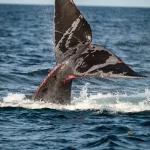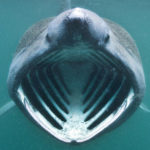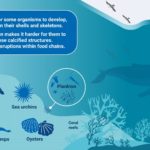The Big from the Small: Basking Shark Diet vs Size
June 18, 2024
What is the first think you think of when you hear the word “shark”?
Is it a bloodthirsty man eater? A huge underwater torpedo with thrashing jaws and sharp teeth? Or is it perhaps the iconic Jaws theme song? Many people who hear the word “shark” immediately think of the horrors portrayed through movies and tv shows regarding these insatiable eating machines. But what if I were to tell you they aren’t exactly correct? In regard to some species at least, these allegations couldn’t be farther from the truth, and instead can be rather detrimental to these species’ reputations.
One such species I am referring to here is the elusive basking shark. This species, despite its name, is actually a fish. And while all sharks do in fact fall under the fish category not all fish fall into the shark category. To be a shark one must have a number of characteristics which distinguishes them from other fish. One such characteristic consists of having a skeleton made out of cartilage rather than one made of bone.
Out of all the fish in the ocean the basking shark is considered to be the second largest fish species in the world, following close behind the magnificent whale shark. These species grow up to maximum lengths of 12 meters (40 feet), and 18 meters (60 feet) respectively, and surprisingly enough these species do not rely on eating other fish to reach these massive lengths.
But if they don’t rely on eating fish to grow this big, they must be eating something much bigger than fish, right?
WRONG! This species is actually a filter-feeder who relies on plankton (small and microscopic organisms who float/drift with the current) as its main food source, much like the baleen whales commonly found throughout the Bay of Fundy. However, dissimilarly to baleen whales, these basking sharks do not have baleen plates, rather they have massive gill slits that extend almost completely around their heads which are lined with gill rakers. These gill rakers are bristle-like and grow to about 10cm in length, with each gill slit carrying between 1000-1300 rakers along each arch. Also referred to as planktivores, basking sharks actively select foraging areas with high densities of plankton, containing both phytoplankton (plants) and zooplankton (tiny animals). When feeding the basking shark will reduce its speed by approximately 24% and its gills and mouth expand massively, filtering approximately two thousand tons of sea water every hour!
But why slow down to eat? Wouldn’t they catch more food if they swam faster? The answer to that is somewhat complicated. While they would in theory catch more prey at higher speeds, they also risk expending very high amounts of energy. Basking sharks require a perfect balance. Swim too slow and they may not filter enough food to fulfil their metabolic needs, or swim too fast and risk wasting more energy than they gain from the prey they catch. This perfectly balanced speed is called optimal foraging speed, where they maximize food ingested with the lowest energetic cost.
But one question still remains. How do they grow so big by eating such small prey?
Let’s break it down into simple terms. In this scenario phytoplankton will contain 1000 units of energy. When the phytoplankton is eaten by zooplankton it loses some energy, so the zooplankton only gains 100 units of energy. The zooplankton is then eaten by a small fish who only gains 10 units of energy, and the predator who eats the fish only gains 1 unit of energy. This trend then continues on until it reaches the top carnivores.
So, in other words, the closer you eat to the bottom of the food chain the higher amounts of energy you will gain. This is why the basking shark is able to grow to such large lengths. Because they feed on phytoplankton and zooplankton, they are able to fulfil their metabolic needs and then, using the abundance of extra energy they have, they are then able to direct it towards other areas such as their growth.
Written by Jayde Rapp
References
Campana, S. E., Shelton, P. A., Simpson, M., & Lawson, J. (2008). Status of basking sharks in Atlantic Canada. Fisheries and Oceans.
How do whale and basking sharks grow so big eating such small food?. Wildlife Online. (n.d.). https://www.wildlifeonline.me.uk/questions/answer/how-do-whale-and-basking-sharks- grow-so-big-eating-such-small-food
Matthews, L. H., & Parker, H. W. (1950, November). Notes on the anatomy and biology of the Basking Shark (Cetorhinus maximus (Gunner)). In Proceedings of the Zoological Society of London (Vol. 120, No. 3, pp. 535-576). Oxford, UK: Blackwell Publishing Ltd.
Sims, D. W. (2000). Filter-feeding and cruising swimming speeds of basking sharks compared with optimal models: they filter-feed slower than predicted for their size. Journal of Experimental Marine Biology and Ecology, 249(1), 65-76.
Sims, D. W., & Quayle, V. A. (1998). Selective foraging behaviour of basking sharks on zooplankton in a small-scale front. Nature, 393(6684), 460-464.



